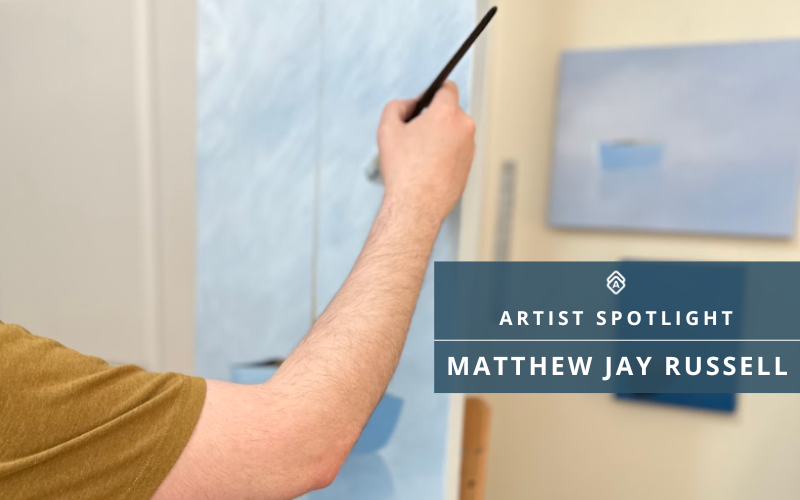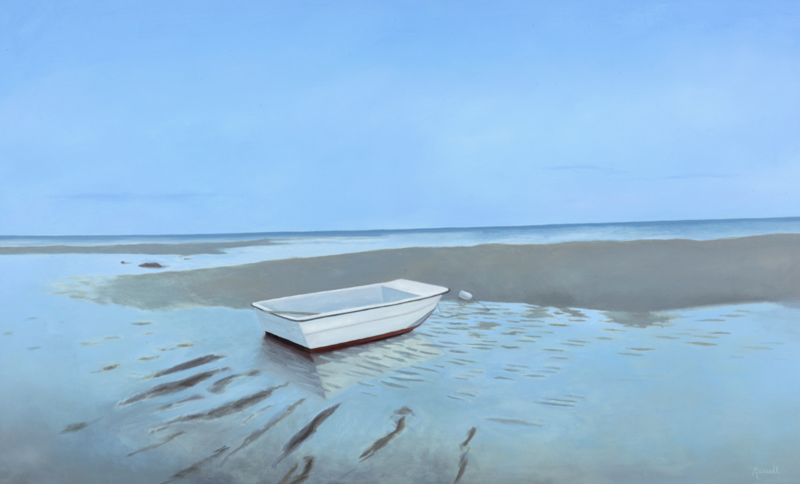“So much of a creative career unfolds slowly—and that’s a good thing,”
Artwork Archive's Featured Artist Matthew Jay Russell knows firsthand that the best work doesn’t happen overnight. Raised in the rural stillness of upstate New York and shaped by years of wandering coastal paths and forest trails, his landscapes are a product of presence and patience. Each piece distills the quiet beauty of nature—the kind most people rush past—into a dreamlike scene that invites you to slow down and stay a while.
Through vibrant color, soft textures, and masterful balance, he's able to capture what a place looks like—and how it feels to stand still inside of it.
Artwork Archive had the chance to chat with Matthew Jay Russell about his creative process, the quiet power behind his pieces, and how Artwork Archive helps him manage his art career.
You can see more of his work on Discovery and learn more about his art practice below:
Matthew Jay Russell Low Tide, 36 x 60 in
Every Painting Begins With an Adventure
For Matthew Jay Russell, the creative process starts long before he ever touches a brush.
"Beginning a painting is always the most fun part for me because it usually starts with an adventure to somewhere inspiring," Russell explains.
Living near both the Adirondack Mountains and the New England coastline, he finds himself surrounded by endless pockets of beauty, always waiting to be discovered.
After an expedition, Russell works from both reference photos and imagination. His first step is choosing a size and composition that match the feeling he wants to evoke. From there, he builds studies and mockups to shape the vision more clearly. "It’s an exciting part of the process," he says, "to bring these visions to life."
In the studio, Russell primarily works in oil paint, using a combination of blending and glazing techniques to layer color, build subtlety, and create depth. It's a patient approach—one that mirrors the quiet persistence he finds in nature itself. To keep the momentum going, he often rotates between two or three paintings at once, allowing drying time to serve as a natural pause between bursts of creativity.
Blue Always Finds Its Way Back In
When it comes to color, Russell gravitates toward one hue with unwavering loyalty.
"I find myself returning to certain colors—especially blue," he reflects. "There’s something about it that’s both calming and expansive."
Blue holds personal and geographic weight for the artist. It defines so much of the New England coastline he knows intimately—the endless ocean, the wide-open sky—and it slips almost instinctively into his paintings. "Blue has a way of capturing that feeling of quiet and renewal," he says, a feeling that serves as a foundation for much of his work.
Still, the artist doesn’t impose color on a landscape; he lets the environment guide him. "I’m very much guided by the landscape itself and will often let that dictate my palette," he notes.
Yet no matter where the path leads, blue often acts as the anchor—the emotional thread tying together place, memory, and experience across his body of work.
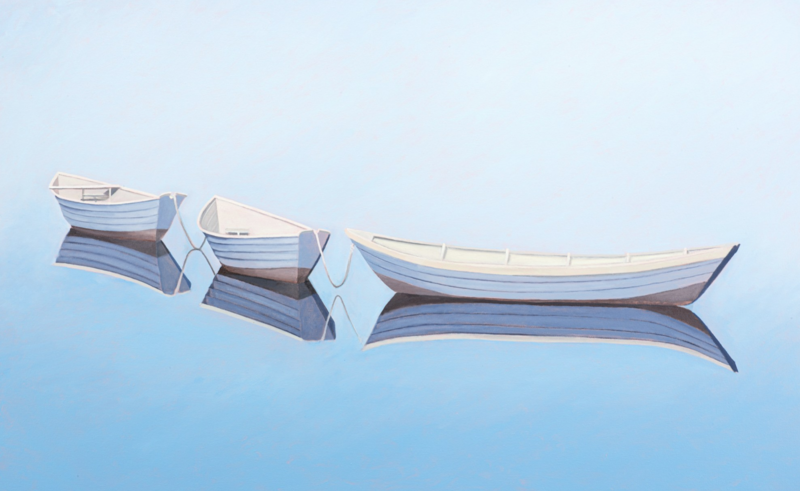
Matthew Jay Russell, Three Dories, 30 x 48 in
The Quiet Power Behind Every Landscape
Russell's landscapes feel like stepping into a dream—serene, grounded, and somehow just a little bit outside of time.
"A sense of calm and rejuvenation is what I aim for viewers to feel when spending time with my work," the artist shares. Nature, especially the coast, is where he feels most at home and at peace. There’s a stillness in those moments, he says, "that grounds me, but there’s also something expansive and emotional, almost like time is suspended."
Russell doesn't chase spectacle when he paints. He leans into something quieter. "When I’m in nature," he says, "I experience a feeling that can only be described as euphoric." That sense lives inside his work, and is poured into each painting, carrying the same stillness and emotional weight he finds out in the wild.
He hopes that anyone who stands in front of his work feels transported—"like they’ve stepped into a space that feels both familiar and dreamlike." If a viewer can feel even a little more centered, more connected, or breathe just a little deeper, the artist considers that a success.
Trusting That Small Steps Matter
Before he had a dedicated studio, before exhibitions and collectors, Matthew Jay Russell carved out a small table in the corner of his bedroom for his creative work. "It was far from ideal, but it was enough to keep going."
"I think one of the most valuable mindset shifts an artist can make is learning to be patient with the process," he says. "It takes time to find your voice, to build genuine relationships with collectors and galleries, and to grow into the kind of artist you want to be."
Early on, the painter felt the pressure to rush—to measure his progress against others, to keep up with invisible timelines. But the real shift happened when he chose to trust the slow, steady rhythm of his own growth.
"You don’t need to sprint to grow," Russell reflects. "You just need to keep going, stay open, and take yourself and your work seriously." Every small, consistent step he took built toward something bigger—whether it was a dedicated studio space or the evolution of his voice.
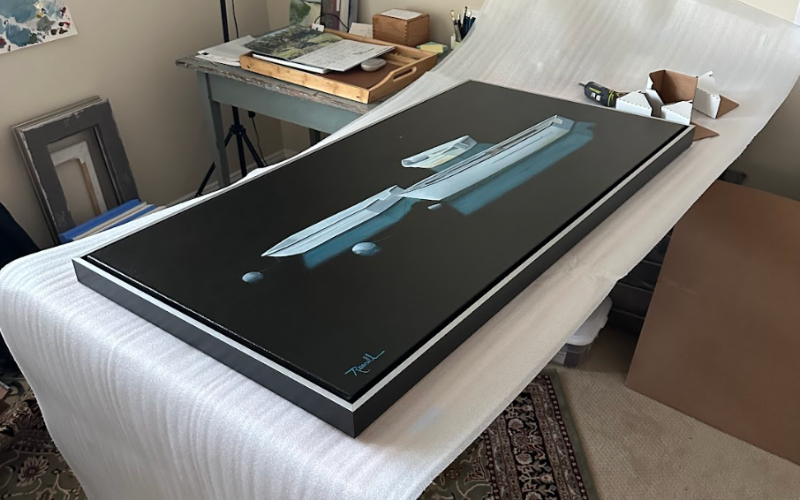
Inside Matthew Jay Tucker's studio. Photo courtesy of the artist
Making Peace With Uncertainty
For Artwork Archive's Featured Artist, one of the greatest challenges of becoming a professional artist wasn't creative block or rejection—it was learning to live without predictable next steps.
"Unlike more traditional career paths, there’s no set roadmap, no guaranteed outcomes," Matthew Jay Russell reflects. Early on, the lack of structure felt overwhelming. Doubts crept in—questions about whether he could make a living doing what he loved, whether his work would resonate beyond the walls of his studio.
But over time, Russell found a way to move through the unknown. "What helped me overcome that was learning to reframe uncertainty as possibility," he explains. He leaned into what he could control: showing up consistently, refining his craft, and staying open to wherever the work wanted to lead him.
Opportunities he once found intimidating—meeting new collectors, participating in shows—became the doorways to elevate his career. And growth, as it turned out, didn't come from knowing exactly what was ahead—it came from being open to it.
Say Yes to More Opportunities Without Dropping the Ball:
Opportunities are everywhere—you just need to find the right ones and have a system to keep up. Start by browsing Artwork Archive’s Complete Guide to 2025 Opportunities to find your next show, residency, or grant.
From there, you can use Exhibitions and Locations to track important dates, manage where your work is showing, and stay ready for whatever doors open next.
When the Business Side Started Taking Over
Matthew Jay Russell is one of those artists that has always valued organization, but there came a point when the back-end demands of running an art career started to encroach on his studio time. Managing sales, tracking expenses, finding new opportunities—it was eating up precious hours he wanted to spend painting.
"I found myself spending more time on the business side of things than I wanted to, which took me away from the easel," Russell shares.
That's when he knew he needed a better system—something more powerful than spreadsheets and sticky notes. He needed something that coule simplify the moving pieces of a growing art career. His search led him to Artwork Archive, a platform built to support artists like him in managing not just inventory, but the full scope of an art business.
"With Artwork Archive, I can do everything in one place," the artist explains. "It’s made it so much easier for me to stay organized, and now I have more time to focus on what I really love— creating my art."
Protect Your Studio Time:
As your art career grows, so do the behind-the-scenes tasks. And when your admin work starts creeping into your painting hours, it's a sign you need a better system.
Artwork Archive keeps everything you need—your inventory, sales, and collector info—in one place, so you’re not losing creative time just trying to stay organized.
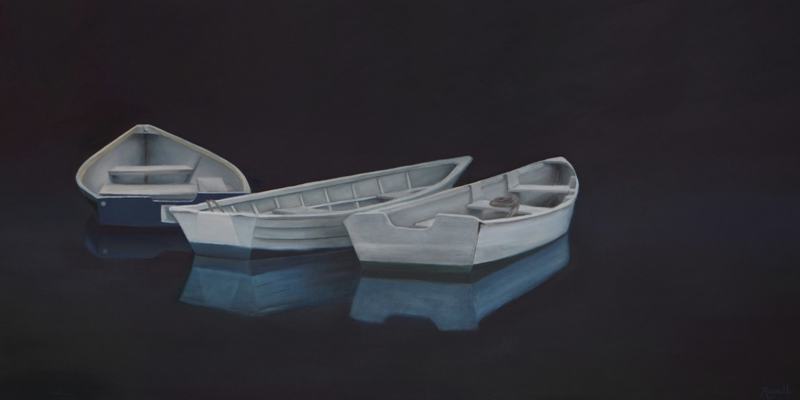
Matthew Jay Russell, Moonlight Gathering, 24 x 48 in.
Building a Living Archive
One of the first things Russell noticed after switching to Artwork Archive was how much smoother managing his career became.
Before finding the platform, his system for managing his artwork looked a lot like most artists'—spreadsheets, scattered notes, mental lists—all things that work...until they don't.
"With Artwork Archive, I can now easily manage important details like location, status, pricing, and exhibition history all in one place," he shares. What changed everything was having a space where his full body of work could live—organized, searchable, and always up to date. Instead of juggling disconnected records, he built a living archive that grows and evolves alongside his art.
And he’s developed a simple but powerful habit: logging new pieces as soon as they’re made. "I’ve gotten into the habit of entering each new piece right away—because it’s surprisingly easy to lose track of inventory, especially as things start moving to galleries, shows, or buyers," Russell admits.
"Artwork Archive has made a huge difference in how I manage my career behind the scenes." And, while he still keeps spreadsheets as a backup, the painter values having a clear, visual map of his career at a glance—one that supports his growth without pulling him away from the easel.
Give Your Artwork a Home (Before It Starts Wandering Off):
It’s way too easy for pieces to slip through the cracks once they leave your studio.
Building a living archive with Artwork Archive means you always know where your work is, what’s available, and what’s already sold—without digging through old notes or trying to remember from memory
Advice for Artists Just Getting Started
Matthew Jay Russell knows that the early years of a professional art career can feel a bit like controlled chaos—part creation, part admin, and a whole lot of guesswork.
"Staying organized is key," he says. "This applies to both your physical studio space and the business side of things—and in turn, it helps keep your mind clear for the creative work ahead." From sorting files to writing to-do lists and using systems like Artwork Archive to track sales and inventory, Russell believes these small steps open up more space for actual studio time.
He also encourages artists to build an online presence, even when it feels draining. "As time-consuming and painstaking as content creation can feel, it’s nearly as important as the artwork itself—it reinforces your brand and helps people connect with your work."
But his most important piece of advice? Embrace imperfection. "Never be afraid to fail or to make something you think is ‘bad,’" Russell says. "Being an artist is about evolution, trial and error, and discovering more of yourself while trying to create something that resonates with others."
The real magic, he says, comes from staying true to who you are—and letting the process shape you.
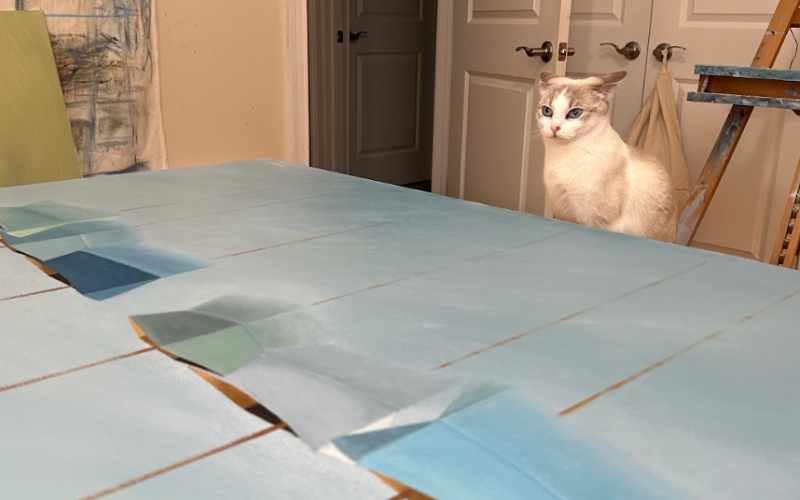 A look inside Matthew Jay Russell's studio (and furry studio assitant). Photo courtesy of the artist
A look inside Matthew Jay Russell's studio (and furry studio assitant). Photo courtesy of the artist
Matthew Jay Russell uses Artwork Archive to get a bigger picture of his art business, inventory each new piece, track his past and upcoming exhibitions, and a lot more.
You can make an online portfolio, catalog your artwork, and generate reports like inventory reports, tear sheets, and invoices in seconds with Artwork Archive. Take a look at Artwork Archive's free trial and start growing your art business.
